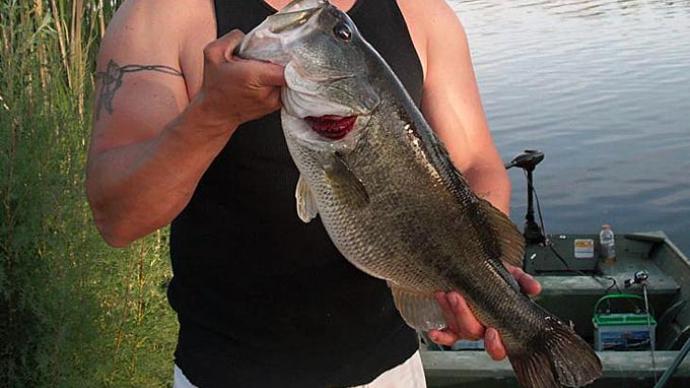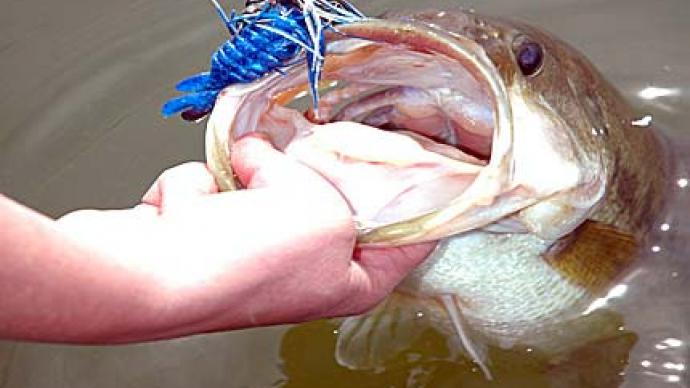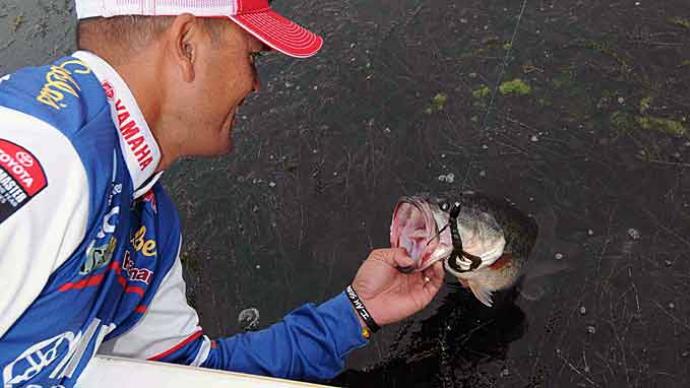
If you’re seeking a Swiss army knife type of lure, your search should start and stop with a jig. Its simple construction — head, hook, skirt, and trailer — belies its versatility. They work year-round and in all scenarios except topwater. Though, a bass angler somewhere is probably working on that.
While all jigs are versatile, some bring specialization, too. As they are inclined to do, anglers and designers tweak jigs to improve their performance in certain situations. Enter the football jig, equipped with an oblong head shaped like its namesake and situated perpendicular to the hook shank. When dragged across the bottom, it causes the jig to wobble, creating a nearly perfect imitation of a crawfish, which is always on a bass's menu.
Football jigs work best at the extremes when wintertime and summertime bass retreat to deep water, where hard cover, such as wood and rock, play a significant role in their locations. They also excel at catching prespawn bass, which pause on mid-depth structures outside shallow flats and wait for prime spawning conditions.
But a football jig doesn’t make magic happen on its own. Getting the most from one requires assembling the perfect setup — rod, reel, line, and lure. They work together, making fishing a football jig easier and more productive. Here is what you need.
Rod
Finding the best rod starts with understanding how football jigs are presented. Long casts are needed to launch them across spots hidden under feet of water. Once on the bottom, they’re dragged across various cover and structure. And when you get a bite, you need a solid hookset, regardless of how far your jig is from your boat.
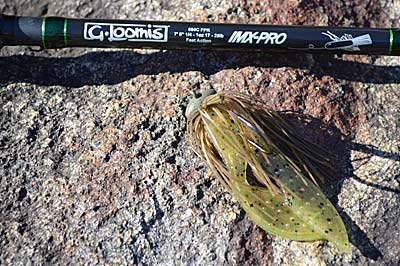
Casting distance comes from two characteristics — length and action. Long rods, for example, generate leverage, increasing lure speed during a cast. That allows them to outcast short ones. So, choose a rod that’s 7 feet or a few inches longer. In addition, its action should be fast — flex limited to its tip. That will allow the rod to load quickly, storing enough energy in your back cast to fling your jig far.
Length plays an essential role in a football jig's retrieve, too. Unlike other types of jigs, which swim and hop through a portion of the water column, a football jig is all about bottom contact. As a result, this rod is short enough to hold its tip down while sliding your jig along comfortably. And its fast action quickly transmits any movement from your jig to your hand, unveiling changes in bottom composition. These can be key to locating deep-water bass.
Along with action, you need to consider the rod’s power. It’s the amount of force that a rod can handle. The heavier the power, for example, the heavier the lure and line rating. Power works independently of action, and you can find rods with any combination of the two. A heavy power is best for football jigs. It’ll easily handle jigs that can weigh upwards of 1 ounce and set the hook and battle big bass at any distance, even on the bottom in deep water or at the end of a long cast.
Reel
The best football jig retrieves start and end with the rod tip. Your reel, for the most part, is along for the ride. So, almost any baitcasting reel will work. But if you want the best, there are a few things to consider.
Find a baitcasting reel with a gear ratio of 7:1 or faster that picks up many inches of line with each turn of its handle. It’ll quickly suck up the slack line while your jig is paused, preparing you to set the hook at a split-second's notice. And it’ll help you keep your line tight while battling bass. Slack line makes it easy for one to throw a heavy jig.
Your reel should have a wide spool, too. That extra line capacity will support long casts and fishing deep water. And that extra line will keep you fishing if you have a tangle or break off your jig.
Line
Your lure, cover, and sometimes bass can be seen in shallow water. But all disappear as water depth increases. While today’s electronics — whether down scan, side scan, or forward-facing sonar — open a window to what’s happening down there, you still need to depend on your sense of feel.
Choosing the best line for your football jig outfit strengthens that connection. And of the most popular choices, fluorocarbon and braided lines bring more to the party than monofilament. Both are strong and abrasion resistant, standing up to the rocks and brush that you’ll drag your football jig over and through. They also stretch less, ensuring solid hook sets at the end of a long cast or on the deepest spots.
Lack of stretch, which is more pronounced in braided line than fluorocarbon, provides one more important purpose. It increases sensitivity. For example, it'll tell you if the bottom is muck, sand, or gravel and where it changes composition. That can be a pivotal place to drag a football jig, especially in late winter and early spring.
Depth and cover should dictate your line's size. For example, if you’re targeting sunken brush, you'll want something strong. Fluorocarbon line of 17- or 20-pound test or 20- or 30-pound test braided line is an excellent place to start. Consider your line's diameter if you’re fishing deep water — 20 feet or more. Thin ones can easily cut through the water, helping your jig sink quickly and stay on the bottom. While this plays a more significant role with crankbaits, you’ll still see benefits when dragging your football jig across deep spots.
Lure
Football jigs work best when they’re stuck to the bottom. It’s there that their oblong head causes it to come to life. But that won’t happen if it planes into the water column or glides off a drop-off. So, the best ones stay put. And they accomplish that with weight.
The most popular jig weight is 3/8 ounce. It’s easy to cast and fishes well in a variety of depths. But the best football jigs are heavier. While a ½-ounce model will work, stepping up to ¾ ounce means your jig will get to the bottom faster and stay there, even if boat movements inadvertently tug on your line or you slide your jig off an underwater ledge.
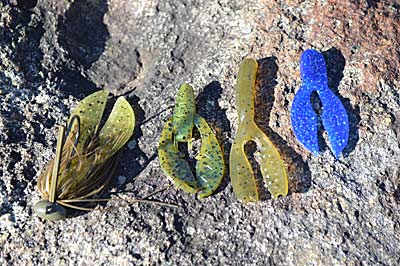
Choose a football jig with a strong hook, at least 4/0 in size. It should have a wide gap, large enough to handle a trailer and hooked bass. But avoid those with extra-wide gaps, which hide the point behind the line tie. A bristle-style weed guard will protect it from snags.
Don’t underestimate the importance of your football jig’s line tie. Traditional ones exit a jig’s head 90 degrees to the hook shank. It can cause the jig to roll forward, standing up its skirt and trailer. That movement can be attractive to bass. Others have a 60-degree line tie that exits more on the front of the jig's head. Use this one when cover is heavy and you need to sneak your jig through it.
Match the pattern of your football jig’s silicone skirt to the conditions. Crawfish colors — natural ones in bright light and clear water and dark ones in low light and stained or muddy water — are best. But don’t be afraid to incorporate a touch of chartreuse, orange or blue, especially if the water is stained or muddy.
You’ll want to add a trailer to your jig. While time-honored pork chunks are making somewhat of a comeback, soft-plastic ones are a better choice for football jigs. They are offered in more colors and sizes and create the best action.
Select a trailer that sports naturally shaped or flat kickers. These will wave as your jig advances, then rise when it rests. That mimics a crawfish’s natural defensive posture, creating a lifelike pose for any following bass and reassuring them it’s OK to eat. Trailers from buoyant materials, such as Z-Man's ElaZtech, help create the action.
Trailers are offered in a variety of sizes. Use them to change the profile of your football jig. For example, a bigger profile is better when targeting big bass or fishing in dirty water. Color is as simple as matching your jig’s skirt. The two should blend to create a natural motif. And if your jig doesn’t have a flash of color, the flake in your trailer can do that. Watermelon with orange flake, for example, is a powerful combination on natural lakes, where smallmouth hunt crawfish.


